Topological Defect-Guided Regular Stacking of Focal Conic Domains in Hybrid-Aligned Smectic Liquid Crystal Shells
Abstract
:1. Introduction
2. Materials and Methods
3. Results
3.1. Cooling Shells with an Inner Phase Based on Regular Water
3.2. Cooling Shells with an Inner Phase That Is Density Matched to the LC at the N-SmA Transition
3.3. Cooling Shells with an Inner Phase That Is Density Matched to the LC in the N Phase, Observed Perpendicular and along Gravity
4. Discussion
5. Conclusions and Outlook
Author Contributions
Funding
Data Availability Statement
Conflicts of Interest
References
- de Gennes, P.G.; Prost, J. The Physics of Liquid Crystals; Clarendon Press: Oxford, UK, 1993. [Google Scholar]
- Kleman, M.; Lavrentovich, O.D. Soft Matter Physics: An Introduction; Springer: Berlin/Heidelberg, Germany, 2002. [Google Scholar]
- Allender, D.W.; Hornreich, R.; Johnson, D. Theory of the stripe phase in bend-Freedericksz-geometry nematic films. Phys. Rev. Lett. 1987, 59, 2654. [Google Scholar] [CrossRef]
- Pergamenshchik, V. Surfacelike-elasticity-induced spontaneous twist deformations and long-wavelength stripe domains in a hybrid nematic layer. Phys. Rev. E 1993, 47, 1881. [Google Scholar] [CrossRef]
- Sparavigna, A.; Lavrentovich, O.; Strigazzi, A. Periodic stripe domains and hybrid-alignment regime in nematic liquid crystals: Threshold analysis. Phys. Rev. E 1994, 49, 1344. [Google Scholar] [CrossRef] [PubMed] [Green Version]
- Lavrentovich, O.; Pergamenshchik, V. Stripe domain phase of a thin nematic film and the K 13 divergence term. Phys. Rev. Lett. 1994, 73, 979. [Google Scholar] [CrossRef] [Green Version]
- Lavrentovich, O.; Pergamenshchik, V. Patterns in thin liquid crystal films and the divergence (“surfacelike”) elasticity. In Liquid Crystals in the Nineties and Beyond; World Scientific: Singapore, 1995; pp. 251–299. [Google Scholar]
- Krzyzański, D.; Derfel, G. Structure of spontaneous periodic deformations in hybrid aligned nematic layers. Phys. Rev. E 2001, 63, 021702. [Google Scholar] [CrossRef]
- Barbero, G.; Pergamenshchik, V. Intermediate periodic “saddle-splay” nematic phase in the vicinity of a nematic-smectic-A transition. Phys. Rev. E 2002, 66, 051706. [Google Scholar] [CrossRef] [PubMed]
- Cladis, P.; Torza, S. Growth of a smectic-A from a bent nematic phase and smectic light valve. J. Appl. Phys. 1975, 46, 584–599. [Google Scholar] [CrossRef]
- Pergamenshchik, V.; Lelidis, I.; Uzunova, V. Stripe domains in a nearly homeotropic nematic liquid crystal: A bend escaped state at a nematic-smectic-A transition. Phys. Rev. E 2008, 77, 041703. [Google Scholar] [CrossRef]
- Zappone, B.; Lacaze, E. Surface-frustrated periodic textures of smectic-A liquid crystals on crystalline surfaces. Phys. Rev. E 2008, 78. [Google Scholar] [CrossRef]
- Delabre, U.; Richard, C.; Cazabat, A. Thin Nematic Films on Liquid Substrates (dagger). J. Phys. Chem. B 2008, 113, 3647–3652. [Google Scholar] [CrossRef] [Green Version]
- Gim, M.; Beller, D.; Yoon, D. Morphogenesis of liquid crystal topological defects during the nematic-smectic A phase transition. Nat. Commun. 2017, 8, 15453. [Google Scholar] [CrossRef] [Green Version]
- Meyer, C.; Cunff, L.; Belloul, M. Focal Conic Stacking in Smectic A Liquid Crystals: Smectic Flower and Apollonius Tiling. Materials 2009, 2, 499. [Google Scholar] [CrossRef] [Green Version]
- Beller, D.; Gharbi, M.; Honglawan, A.; Stebe, K.; Yang, S.; Kamien, R. Focal Conic Flower Textures at Curved Interfaces. Phys. Rev. X 2013, 3, 041026. [Google Scholar] [CrossRef] [Green Version]
- Bouligand, Y. Recherches sur les textures des états mésomorphes-1. Les arrangements focaux dans les smectiques: Rappels et considérations théoriques. J. Phys. 1972, 33, 525–547. [Google Scholar] [CrossRef]
- Kléman, M.; Lavrentovich, O.D. Grain boundaries and the law of corresponding cones in smectics. Eur. Phys. J. E 2000, 2, 47–57. [Google Scholar] [CrossRef]
- Kleman, M.; Meyer, C.; Nastishin, Y.A. Imperfections in focal conic domains: The role of dislocations. Philos. Mag. 2006, 86, 4439–4458. [Google Scholar] [CrossRef] [Green Version]
- Kleman, M.; Lavrentovich, O.D. Liquids with conics. Liq. Cryst. 2009, 36, 1085–1099. [Google Scholar] [CrossRef]
- Yoon, D.; Choi, M.; Kim, Y.; Kim, M.; Lavrentovich, O.; Jung, H. Internal structure visualization and lithographic use of periodic toroidal holes in liquid crystals. Nat. Mater. 2007, 6, 866–870. [Google Scholar] [CrossRef]
- Zappone, B.; Meyer, C.; Bruno, L.; Lacaze, E. Periodic lattices of frustrated focal conic defect domains in smectic liquid crystal films. Soft Matter 2012, 8, 4318–4326. [Google Scholar] [CrossRef]
- Ok, J.M.; Kim, Y.H.; Jeong, H.S.; Yoo, H.W.; Kim, J.H.; Srinivasarao, M.; Jung, H.T. Control of periodic defect arrays of 8CB (4’-n-octyl-4-cyano-biphenyl) liquid crystals by multi-directional rubbing. Soft Matter 2013, 9, 10135. [Google Scholar] [CrossRef]
- Honglawan, A.; Beller, D.A.; Cavallaro, M.; Kamien, R.D.; Stebe, K.J.; Yang, S. Topographically induced hierarchical assembly and geometrical transformation of focal conic domain arrays in smectic liquid crystals. Proc. Natl. Acad. Sci. USA 2013, 110, 34–39. [Google Scholar] [CrossRef] [Green Version]
- Kim, Y.H.; Lee, J.O.; Jeong, H.S.; Kim, J.H.; Yoon, E.K.; Yoon, D.K.; Yoon, J.B.; Jung, H.T. Optically Selective Microlens Photomasks Using Self-Assembled Smectic Liquid Crystal Defect Arrays. Adv. Mater. 2010, 22, 2416. [Google Scholar] [CrossRef] [PubMed]
- Serra, F.; Gharbi, M.A.; Luo, Y.; Liu, I.B.; Bade, N.D.; Kamien, R.D.; Yang, S.; Stebe, K.J. Curvature-Driven, One-Step Assembly of Reconfigurable Smectic Liquid Crystal “Compound Eye” Lenses. Adv. Opt. Mater. 2015, 3, 1287–1292. [Google Scholar] [CrossRef] [Green Version]
- Lopez-Leon, T.; Fernandez-Nieves, A. Drops and shells of liquid crystal. Colloid Polym. Sci. 2011, 289, 345–359. [Google Scholar] [CrossRef]
- Urbanski, M.; Reyes, C.G.; Noh, J.; Sharma, A.; Geng, Y.; Jampani, V.S.R.; Lagerwall, J.P. Liquid crystals in micron-scale droplets, shells and fibers. J. Phys. Condens. Matter 2017, 29, 133003. [Google Scholar] [CrossRef] [PubMed] [Green Version]
- Lopez-Leon, T.; Fernandez-Nieves, A. Topological transformations in bipolar shells of nematic liquid crystals. Phys. Rev. E 2009, 79, 021707. [Google Scholar] [CrossRef]
- Noh, J.; Reguengo De Sousa, K.; Lagerwall, J.P.F. Influence of interface stabilisers and surrounding aqueous phases on nematic liquid crystal shells. Soft Matter 2016, 12, 367–372. [Google Scholar] [CrossRef] [PubMed]
- Noh, J.; Wang, Y.; Liang, H.L.; Jampani, V.S.R.; Majumdar, A.; Lagerwall, J.P.F. Dynamic tuning of the director field in liquid crystal shells using block copolymers. Phys. Rev. Res. 2020, 2, 033160. [Google Scholar] [CrossRef]
- Sharma, A.; Lagerwall, J.P.F. Influence of head group and chain length of surfactants used for stabilising liquid crystal shells. Liq. Cryst. 2018, 45, 2319–2328. [Google Scholar] [CrossRef]
- Liang, H.L.; Zentel, R.; Rudquist, P.; Lagerwall, J. Towards tunable defect arrangements in smectic liquid crystal shells utilizing the nematic-smectic transition in hybrid-aligned geometries. Soft Matter 2012, 8, 5443–5450. [Google Scholar] [CrossRef] [Green Version]
- Liang, H.; Noh, J.; Zentel, R.; Rudquist, P.; Lagerwall, J. Tuning the defect configurations in nematic and smectic liquid crystalline shells. Philos. Transact. A Math. Phys. Eng. Sci. 2013, 371, 20120258. [Google Scholar] [CrossRef] [PubMed]
- Utada, A.; Lorenceau, E.; Link, D.R.; Kaplan, P.D.; Stone, H.A.; Weitz, D.A. Monodisperse double emulsions generated from a microcapillary device. Science 2005, 308, 537–541. [Google Scholar] [CrossRef] [PubMed] [Green Version]
- Noh, J.; Henx, B.; Lagerwall, J.P. Taming Liquid Crystal Self-Assembly: The Multifaceted Response of Nematic and Smectic Shells to Polymerization. Adv. Mater. 2016, 28, 10170–10174. [Google Scholar] [CrossRef] [Green Version]
- Sandmann, M.; Würflinger, A. PVT measurements on 4?-n-octyl-biphenyl-4-carbonitrile (8CB) up to 300 MPa. Zeitschrift für Naturforschung A 1998, 53, 787–792. [Google Scholar] [CrossRef]
- Kralj, S.; Zumer, S. Smectic-A structures in submicrometer cylindrical cavities. Phys. Rev. E 1996, 54, 1610–1617. [Google Scholar] [CrossRef] [Green Version]
- Meyer, R.B. On the existence of even indexed disclinations in nematic liquid crystals. Philos. Mag. 1973, 27, 405–424. [Google Scholar] [CrossRef]
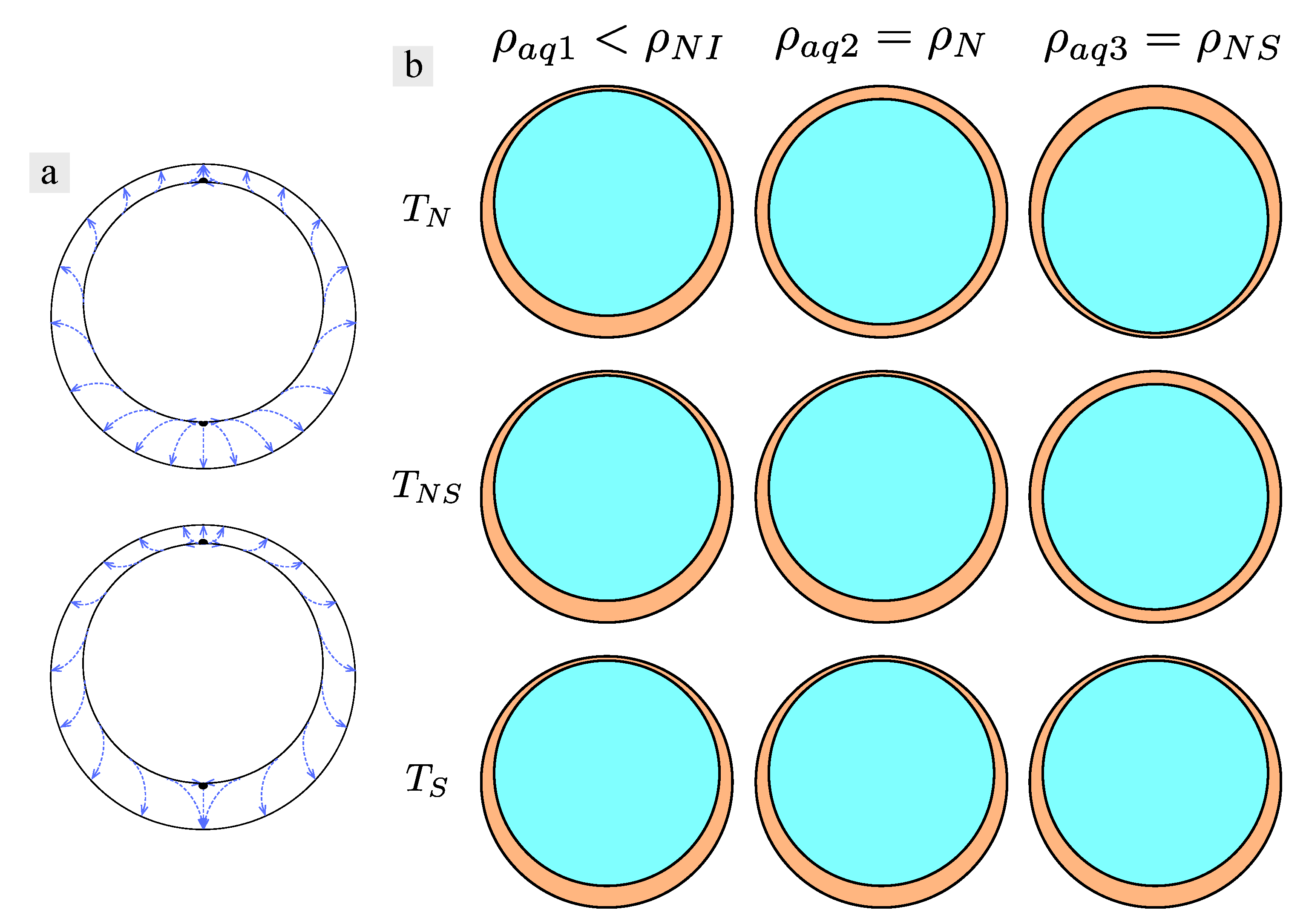
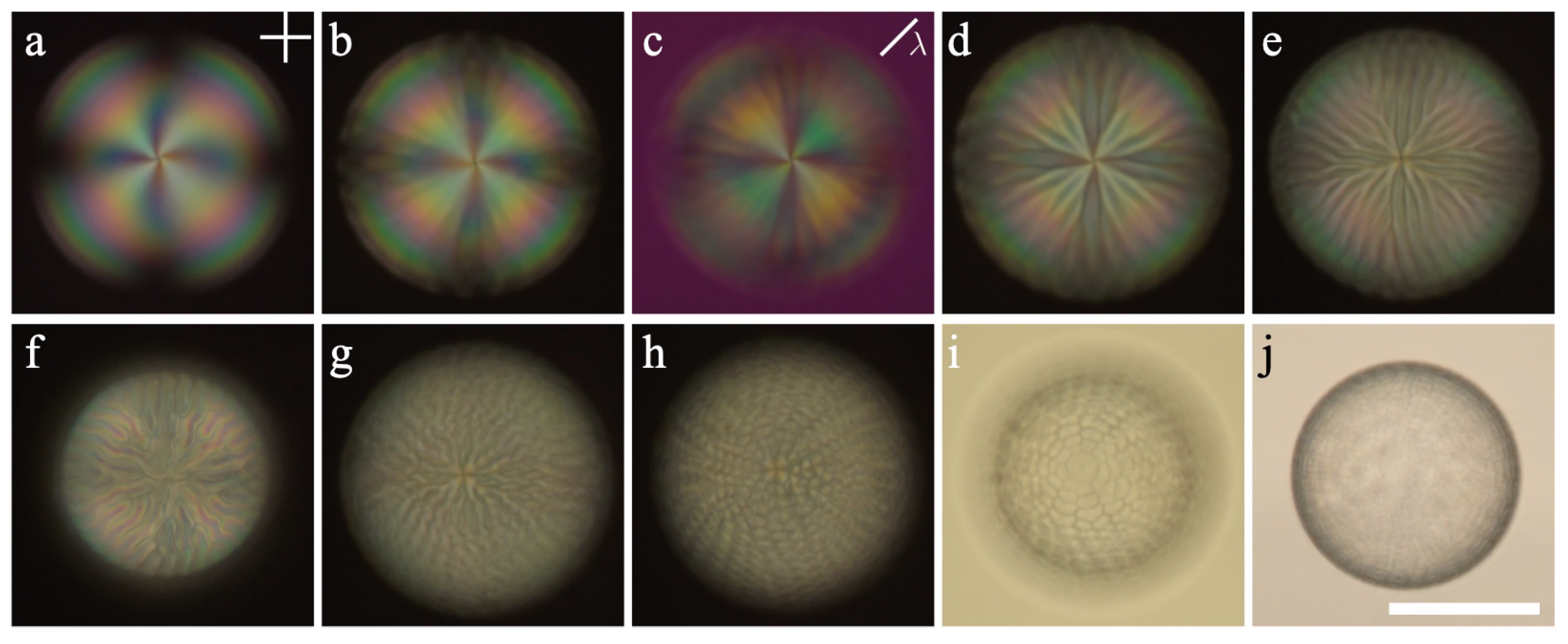
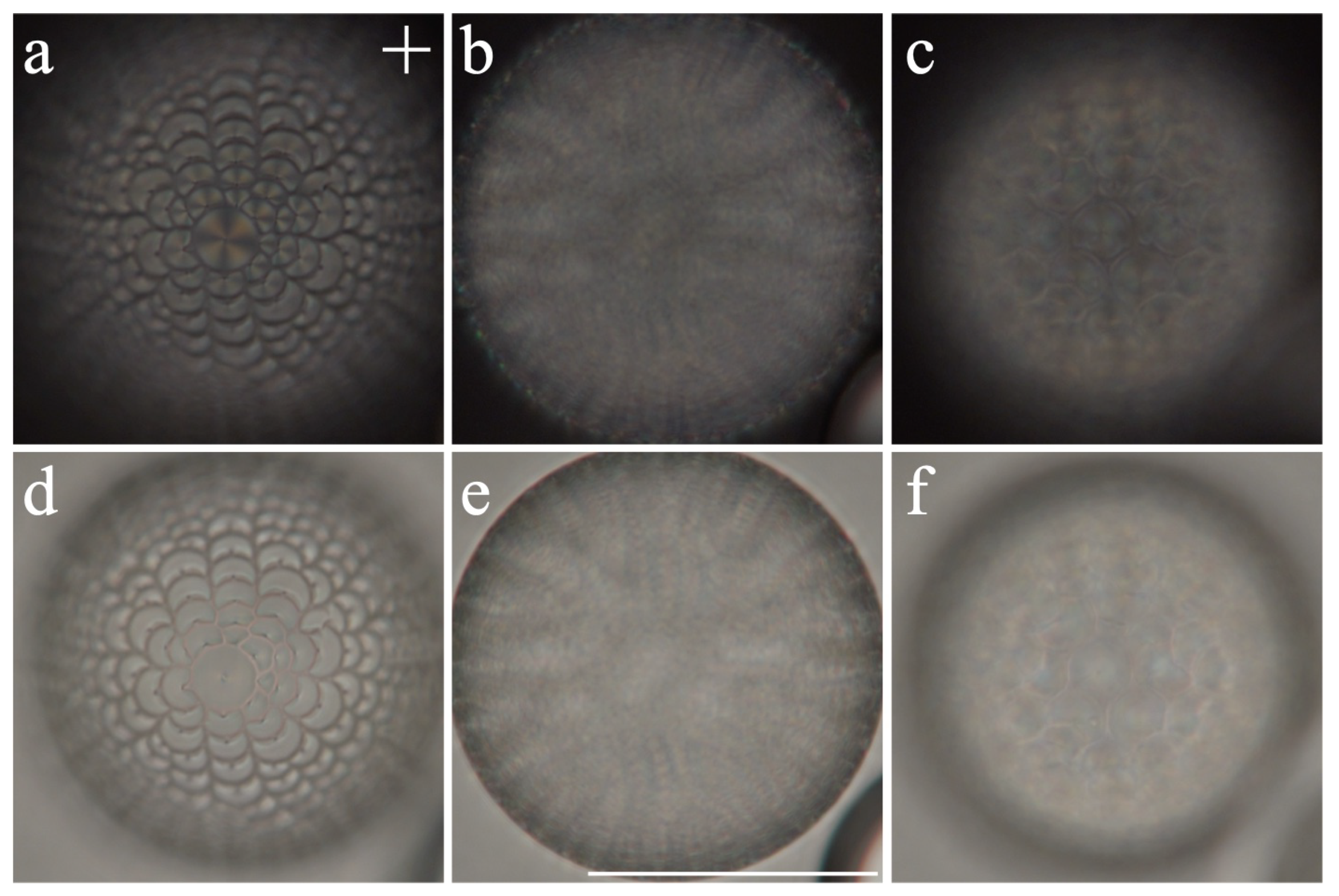
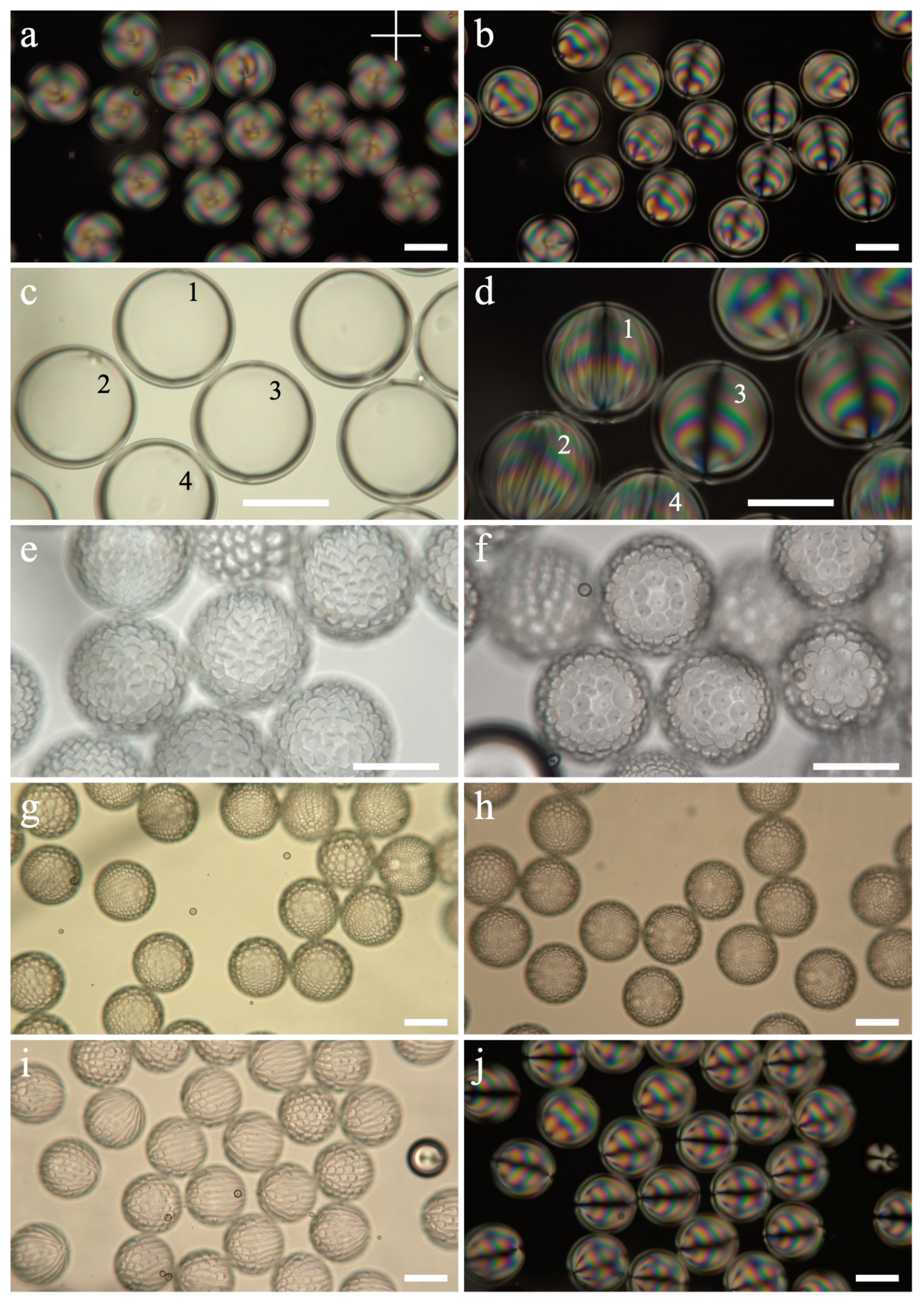
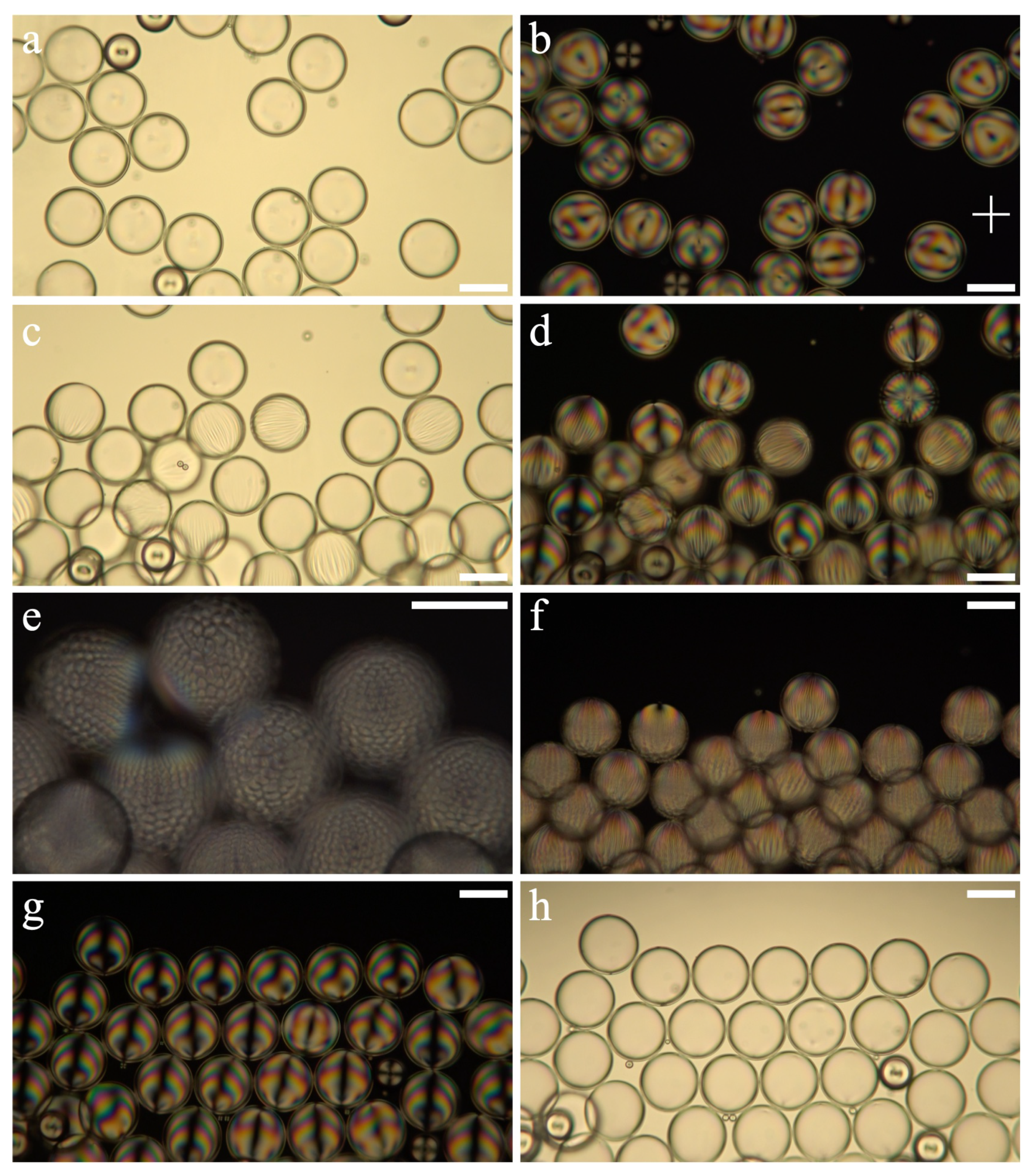
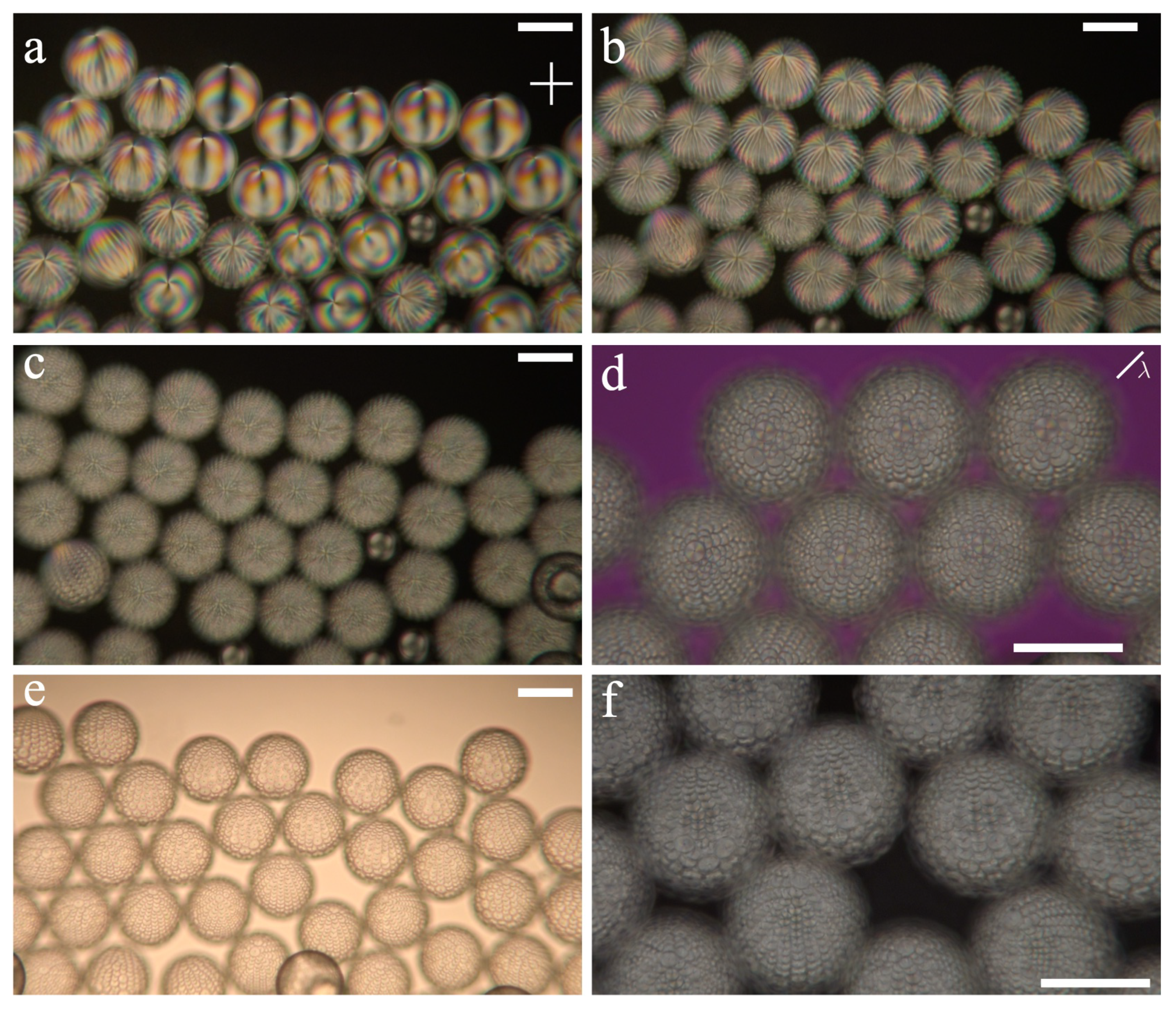
Publisher’s Note: MDPI stays neutral with regard to jurisdictional claims in published maps and institutional affiliations. |
© 2021 by the authors. Licensee MDPI, Basel, Switzerland. This article is an open access article distributed under the terms and conditions of the Creative Commons Attribution (CC BY) license (https://creativecommons.org/licenses/by/4.0/).
Share and Cite
Noh, J.; Lagerwall, J.P.F. Topological Defect-Guided Regular Stacking of Focal Conic Domains in Hybrid-Aligned Smectic Liquid Crystal Shells. Crystals 2021, 11, 913. https://doi.org/10.3390/cryst11080913
Noh J, Lagerwall JPF. Topological Defect-Guided Regular Stacking of Focal Conic Domains in Hybrid-Aligned Smectic Liquid Crystal Shells. Crystals. 2021; 11(8):913. https://doi.org/10.3390/cryst11080913
Chicago/Turabian StyleNoh, JungHyun, and Jan P. F. Lagerwall. 2021. "Topological Defect-Guided Regular Stacking of Focal Conic Domains in Hybrid-Aligned Smectic Liquid Crystal Shells" Crystals 11, no. 8: 913. https://doi.org/10.3390/cryst11080913
APA StyleNoh, J., & Lagerwall, J. P. F. (2021). Topological Defect-Guided Regular Stacking of Focal Conic Domains in Hybrid-Aligned Smectic Liquid Crystal Shells. Crystals, 11(8), 913. https://doi.org/10.3390/cryst11080913





